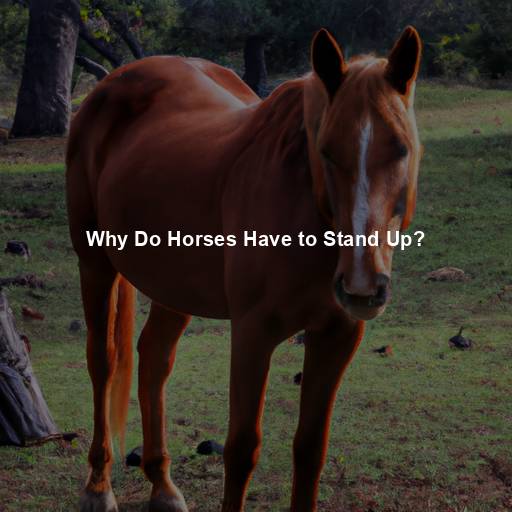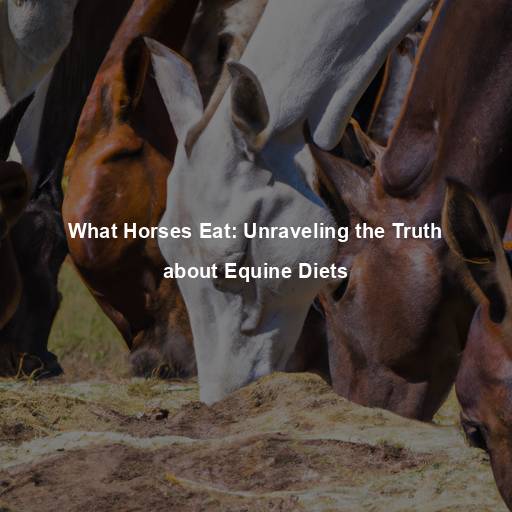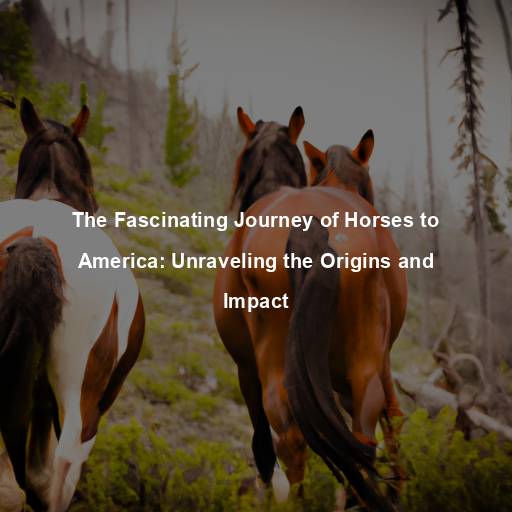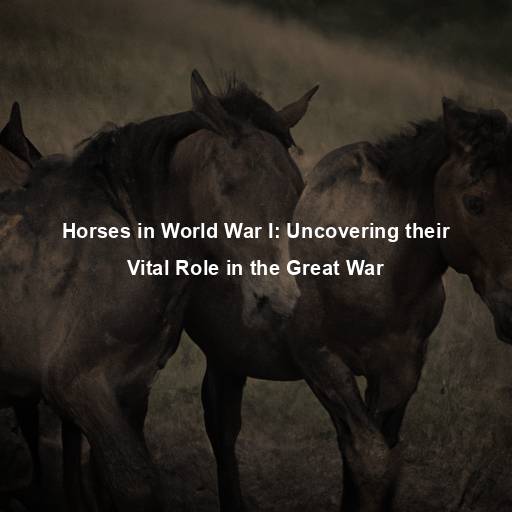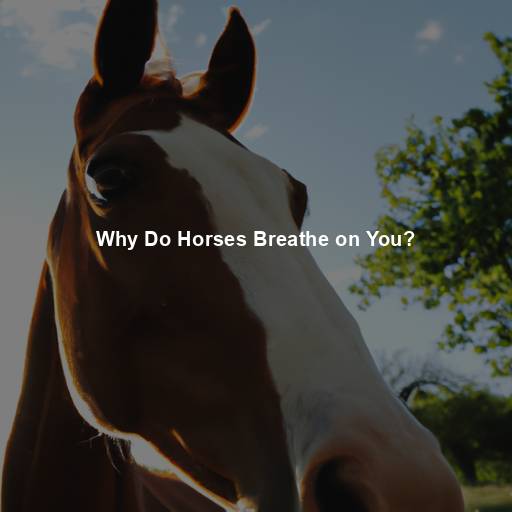Why Do Horses Have to Stand Up?
Last Updated on November 3, 2023 by Evan
Contents
- 1 The Fascinating World of Horses
- 1.1 Understanding the Equine Anatomy
- 1.2 The Importance of Weight Distribution
- 1.3 The Role of the Stay Apparatus
- 1.4 Sleeping While Standing
- 1.5 The Importance of Blood Flow
- 1.6 Social Dynamics and Safety
- 1.7 The Equine Digestive System
- 1.8 Avoiding Pressure Sores
- 1.9 The Complexity of Horse Behavior
- 1.10 The Mechanics of Standing
- 1.11 The Role of Tendons and Ligaments
- 1.12 The Stay Apparatus in Detail
- 1.13 The Physiology of Sleep
- 1.14 Lying Down for Deep Sleep
- 1.15 The Importance of Rolling
- 2 The Psychological Aspects of Standing
- 3 The Role of Standing in Domesticated Horses
- 4 FAQs: Why Do Horses Have to Stand Up?
The Fascinating World of Horses
Horses, with their majestic presence and incredible strength, have captivated humans for centuries. These magnificent creatures have been our companions, our means of transportation, and even our partners in various sports and activities. But have you ever wondered why horses spend most of their time standing up? In this article, we will delve into the reasons behind this intriguing behavior and explore the fascinating world of equine physiology and behavior.
Understanding the Equine Anatomy
Horses, those enigmatic creatures we are enamored with, have an intriguing way of existence that keeps us pondering. It is in their very essence to stand tall, but the reasons behind this peculiar behavior are far from simple. The intricacies lie within their anatomy, an intricate design that baffles the mind. With their statuesque frames and slender limbs, horses navigate a world where vulnerability becomes a formidable foe.
The Importance of Weight Distribution
One of the primary reasons horses stand up is to distribute their weight evenly across their limbs. By doing so, they alleviate excessive pressure on any single leg and reduce the risk of injury. Imagine carrying a heavy backpack on one shoulder for an extended period, and you’ll understand the strain it places on your body. Horses, being significantly larger and heavier than us, face an even greater challenge in maintaining balance and minimizing stress on their limbs.
The Role of the Stay Apparatus
Have you ever wondered how horses are able to stand with such grace and ease? It’s all thanks to their remarkable stay apparatus. This incredible mechanism, consisting of a complex network of tendons and ligaments, allows them to lock their joints effortlessly. When a horse shifts its weight onto one leg, these magical springs automatically engage, giving the horse the ability to stand for prolonged periods without putting in much effort.
Sleeping While Standing
Another intriguing aspect of horses’ standing behavior is their ability to sleep while being upright. Unlike humans who require a horizontal position for deep sleep, horses have adapted to sleep in a standing position to ensure their survival in the wild. This adaptation allows them to quickly escape from potential predators and remain vigilant while resting. However, horses do still require periods of deep sleep, which they achieve by lying down for short intervals.
The Importance of Blood Flow
Blood circulation is crucial for any living being, and horses are no exception. When horses stand, the continuous movement of their limbs stimulates blood flow, preventing pooling and reducing the risk of circulatory disorders such as edema. Additionally, the rhythmic pumping action of the leg muscles assists in returning blood to the heart, aiding overall cardiovascular health.
Social Dynamics and Safety
Horses, those fascinating beings, indeed have an innate inclination towards socializing and sticking together in the untamed wilderness. Mysteriously, their penchant for standing upright stems from a deep-rooted need to constantly keep a watchful eye on their companions, unyielding guardians of their surroundings. Such elevated vigilance enables horses to swiftly sound the alarm in case of impending danger or, astonishingly, convey a myriad of messages through the enigmatic language of their graceful bodies. Thus, their unwavering stance becomes the cornerstone of their collective welfare, ensuring a harmonious existence for the entire equine clan.
The Equine Digestive System
Did you know that horses have an incredible knack for maintaining a steady food intake? Unlike us humans, they have a rather roomy stomach and a specialized hindgut designed to handle all the fibrous nature has to offer. This means that horses can get their munch on whenever the urge strikes, whether it’s chowing down on a patch of lush grass or nibbling on some hay. It’s all about giving their digestion the best chance to work its magic and absorb those vital nutrients.
Avoiding Pressure Sores
Spending long hours in a horizontal position can take a toll on our equine friends, causing the dreaded pressure sores that target those prominent bony areas. However, horses have a brilliant built-in solution to this predicament – they stand up! By periodically shifting their position from horizontal to vertical, these majestic creatures grant themselves some much-needed respite. This clever maneuver helps distribute pressure more evenly, alleviating the strain that would otherwise burden their bodies while reclining.
The Complexity of Horse Behavior
The intriguing world of equine behavior continues to baffle and astound, as we delve deeper into the realm of horse standing habits. These majestic creatures, with their ancient lineage, have honed their survival techniques over countless generations, crafting a captivating display of adaptability. The act of standing up, with its enigmatic allure, showcases the remarkable resilience of horses as they navigate the intricacies of their ever-changing surroundings.
The Mechanics of Standing
When a horse stands, its legs act as pillars, supporting the weight of its body. The bones, tendons, and ligaments work in harmony to maintain stability and balance. The hooves, made of keratin, provide a solid base for weight-bearing and distribute the horse’s weight evenly across the ground. This distribution of weight minimizes strain on any single leg and reduces the risk of injury or fatigue.
The Role of Tendons and Ligaments
The graceful elegance of a horse’s movement is thanks to the unsung heroes within their bodies – tendons and ligaments. In a fascinating symphony of support and stability, tendons connect muscles to bones, propelling the horse forward with each stride. Meanwhile, ligaments interlace bone to bone, creating a sturdy framework of joints that prevent any unruly movements. Together, these invaluable connective tissues keep the noble creature standing tall, their stoic limbs a testament to the marvels of anatomy.
The Stay Apparatus in Detail
The stay apparatus, oh what a marvel! It’s like a secret code of the equine world, allowing our majestic horses to defy gravity without breaking a sweat. Picture this: the hind limbs, with their magical ensemble of the patella, reciprocal apparatus, and suspensory ligament, working in perfect harmony to create a lockdown. As if frozen in time, the patella secures the leg, rendering it immovable and sparing those precious muscles from strain.
The Physiology of Sleep
Horses have a unique sleep pattern called polyphasic sleep, which means they alternate between periods of sleep and wakefulness throughout the day and night. While standing, horses can enter a light sleep known as “dozing”. During this state, their muscles relax, and their heads may droop slightly. This light sleep allows horses to rest and rejuvenate while remaining alert to potential dangers in their surroundings.
Lying Down for Deep Sleep
While horses can sleep standing up, they still require deep sleep for their overall well-being. To achieve deep sleep, horses need to lie down for short periods. When a horse lies down, it can enter REM (rapid eye movement) sleep, which is essential for brain function and overall restfulness. During REM sleep, horses may twitch or move their legs, indicating that they are experiencing vivid dreams.
The Importance of Rolling
It’s absolutely fascinating how horses, in addition to their mastery of lying down, possess an irresistible urge to engage in an intriguing behavior – rolling on the ground. This peculiar activity actually serves a multitude of purposes for these majestic creatures. Not only does rolling help them achieve and maintain a remarkable skin and coat condition, but it also functions as a therapeutic exercise, relieving any uneasiness or irritation they might be encountering. The act of rolling even stimulates blood circulation, ensuring a lustrous and vibrant coat.
The Psychological Aspects of Standing
Horses, captivating creatures of grace and strength, possess a complex web of motivations that guide their decision to stay on their sturdy hooves. Beyond the obvious physical reasons, the inner workings of their minds beckon us to explore the psychological labyrinth behind their choice to maintain an upright stance. To truly grasp this enigmatic behavior, we must delve into the intricate tapestry of equine thoughts and emotions, unraveling the threads that weave together their innate instincts and learned behaviors.
Herd Dynamics and Safety
In the captivating realm of equine dynamics, horses reveal their social expertise through a remarkable herd mentality. Standing gracefully, these magnificent creatures engage in a captivating dance of social interplay, nurturing the bonds that unite them. This intricate form of connection, established through visual cues and nonverbal communication, is the very essence that sustains their emotional stability and imbues them with a profound sense of security. By assuming this majestic stance, horses effortlessly communicate their intentions and effectively safeguard the collective well-being of their esteemed group.
Heightened Vigilance
Horses, majestic creatures of instinct and grace, possess an innate ability to rise above the ground, remaining ever watchful as they navigate the mysterious tapestry of their surroundings. With every graceful stride, their heightened vantage point endows them with an enviable panoramic view, a privileged glance into the secrets of the world around them. Equipped with finely attuned senses, their ears twitching with anticipation and their eyes capturing even the faintest glimmer of danger, horses stand as sentinels of survival. Instinctively poised on their agile feet, they embody a captivating blend of elegance and alertness, ready to respond to any flicker of uncertainty in the ever-changing theater of life.
Maintaining Dominance Hierarchy
Within a herd, horses establish a dominance hierarchy, with certain individuals holding higher social ranks than others. Standing up may be a display of dominance, as horses can appear taller and more imposing when on their feet. By asserting their dominance, horses can establish and maintain their position within the social structure.
The Role of Standing in Domesticated Horses
While the reasons for standing in horses have evolutionary origins, it is essential to consider the context of domesticated horses and their interaction with humans.
Interaction with Humans
Throughout the ages, the profound kinship between humans and domesticated horses has flourished, weaving an intricate tapestry of connection. It is fascinating to delve into the symbiotic relationship that has evolved over centuries, where the act of standing has become a pivotal element in their intricate dance of interaction. Through this seemingly mundane yet deeply significant behavior, horses have bestowed upon us the incredible ability to engage with them on a multitude of levels. The art of grooming, saddling, and even riding is made effortlessly attainable as horses gracefully stand, allowing us to navigate their world with awe-inspiring ease.
Training and Performance
The world of horse training is a complex tapestry woven with countless threads, and one often overlooked but vital element is the art of standing. Just imagine, these majestic creatures must find stillness amidst the chaos, remaining in perfect balance as they undergo grooming, medical procedures, and even the weight of a rider. It is a delicate dance, requiring both patience and focus, for a horse’s safety and the success of their training sessions. And let’s not forget the incredible display of grace seen in equestrian disciplines like dressage and show jumping, where horses must stand with calm composure, poised for the intricate movements that are to come.
FAQs: Why Do Horses Have to Stand Up?
Why do horses need to stand up?
Horses need to stand up primarily to maintain proper blood circulation and prevent health issues. Standing allows horses to distribute their weight evenly and helps prevent pressure sores or injuries that may result from prolonged lying down. Additionally, standing allows horses to be alert and ready to react to their surroundings, ensuring their safety in case of potential dangers.
Can horses sleep while standing up?
Did you know that horses possess a fascinating ability to catch some Z’s while remaining in an upright position? It’s true! Through their extraordinary “stay apparatus” in their legs, horses can actually lock their knees and loosen the necessary muscles for standing, all while maintaining their remarkable balance. This peculiar adaptation permits these majestic creatures to partake in brief moments of rest without having to recline fully, ensuring they can swiftly spring back into action whenever the need arises. The equine world never ceases to astound us!
Do horses ever lie down to sleep?
Yes, horses do lie down to sleep, but they generally sleep while lying down for only short periods of time. Most horses prefer to sleep while standing up as it allows them to remain prepared and aware of their surroundings. Lying down during sleep is more common in horses that feel safe and secure in their environment, such as those in a familiar stable or pasture.
What health issues can occur if horses don’t stand up?
It’s no secret that horses need to get up and on their feet regularly to avoid experiencing a whole host of health concerns. Without regular standing, these majestic creatures can find themselves tangled in a web of circulatory issues, from pesky pressure sores to restricted blood flow in certain parts of their body. Standing is a crucial element in the grand symphony of digestion, as it aids in the smooth movement of food through their complex digestive system. Furthermore, prolonged periods spent lying down can result in unpleasant muscle stiffness and joint dilemmas, leaving our equine friends feeling less than sprightly and limiting their graceful mobility.
How often do horses need to stand up?
As majestic and graceful creatures, horses have a captivating way of balancing their hours spent standing and strolling. While they possess the ability to remain upright for extended periods, they also quietly embrace moments of respite. Each horse, with its own unique rhythm, determines the frequency of these interludes, ensuring their well-being. It is advised to provide these magnificent creatures a haven of solace where they can lay comfortably, offering a tranquil respite whenever they desire.
Can horses sleep lying down without being harmed?
A peculiar query often arises among horse enthusiasts – can these majestic creatures truly find solace in slumber while reclining or must they remain on their feet, perpetually alert? This intricate matter holds a hint of fascination, as horses, in fact, can indeed partake in horizontal repose, albeit under certain conditions. When horses descend into the world of dreams, they enter a state of slumber that is tinged with vigilance, a sleep so delicate that it allows them to promptly respond to any imminent dangers lurking in the shadows. Nevertheless, a perplexing conundrum surfaces – how can we ensure the sanctity of the equine slumber domain? Delicate care must be administered to safeguard the dozing area from lurking perils that could bring harm to these noble beasts – rusted, jagged objects, treacherously uneven ground, or even the presence of their fellow hoofed companions who may inadvertently trample upon them, unaware of their dormant state.

